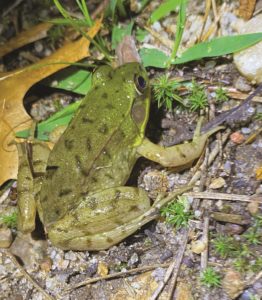TRURO — The shallow rim of a pond populated by toddlers and their watchful parents may be the last place on Cape Cod where you would expect to see an argument between two grown men.
But it happened at Great Pond in Truro during the hottest part of July, on one of those days when families flock to this oasis of calm and serenity near the Wellfleet border.

It is a place where youngsters possessing zero swimming ability can frolic safely with their parents close by. And there is an added bonus in the shallows among the lily pads and muddy tree roots: frogs.
Generations of children have come here to catch them, hovering over the small slimy creatures with cupped hands, nets, and buckets. It is a Cape Cod tableau in the style of Norman Rockwell Americana.
But is it good for the frogs?
That question was at the crux of the scene at Great Pond when a father of two small children approached another (taller and slightly more muscular) dad. Dad number one told dad number two that it was wrong for dad number two to allow his children to collect a pile of frogs and keep them in a plastic bucket for an extended time in the hot sun.
People sitting nearby on the compact beachfront avoided eye contact as other children — possibly their own — continued chasing frogs.
Dad number two started to walk away after saying, “OK, we heard you.” But dad number one kept talking.
“You say you heard me, but it is not allowed,” he said. “There is a sign up there that clearly says it is not allowed.”
Great Pond in Truro and many other kettle ponds on the Outer Cape are inside the boundaries of the Cape Cod National Seashore. The National Park Service posts signs pondside warning that disturbing plants and animals is prohibited. Violate the rule and you could get up to six months in jail or a $10,000 fine, says Seashore Supt. Brian Carlstrom.
But little frog hunters are not likely to get locked up. Carlstrom said that during the height of the season law enforcement rangers are so busy they would probably not be able to get to the pond in time to rescue a bucket of frogs.
Naturally, Carlstrom hopes pond visitors will police themselves.
“You never really want to take any animal out of its natural environment,” he says.
Ian Ives, director of the Long Pasture Wildlife Sanctuary of the Massachusetts Audubon Society in Cummaquid, has studied amphibians on the Cape for decades. He says there is a big difference between picking up a frog and putting it back where you found it and collecting frogs in a bucket. He also acknowledges the importance of encouraging children to learn firsthand about the environment.
“I don’t know if there is any tried-and-true agreement on this,” Ives says. “There are opportunities to learn and make a connection with wildlife, because if you don’t love wildlife, you will not protect it.”
Touch and feel are ways that children form bonds with animals. That could be important when they become old enough to do something to protect them, Ives says.
“Putting 50 toads in a bucket? That is definitely not cool,” Ives says. “But should you let a kid hold a turtle and pass it around? It is not easy. And there is no clear answer. But I am on the side of allowing touch.”

Perhaps one argument against buckets filled with amphibians is that frogs, says Ives, are natural cannibals. Their menu in the wild might include an occasional fellow frog, but trapping a bunch of amphibians of varying species in a bucket creates a queasy buffet where frogs are both diners and dinners.
“If you had bullfrogs and green frogs of different sizes in a bucket, then, yes, they might eat each other,” he says.
There are nine frog and toad species on Cape Cod: the American toad, American bullfrog, Eastern spadefoot, Fowler’s toad, gray treefrog, green frog, pickerel frog, spring peeper, and the wood frog. Ives says the most common are the American bullfrog and the green frog.
None face the danger of disappearing on the Outer Cape because of the preservation of the National Seashore, but the spadefoot toad is listed as threatened by habitat loss elsewhere in the state.
Bob Cook, a retired Seashore wildlife ecologist who has written extensively about frogs, says Park Service ecologists have monitored amphibians since 2003, determining there is a “robust amphibian community” in the Seashore, which encompasses most of Provincetown, Truro, Wellfleet, and Eastham.
Green frogs are plentiful, and they are likely to be the type children catch around the ponds.
“It would be impossible to remove them from Cape Cod,” Ives says.
The call of the green frog has a “loose banjo string glunk,” according to the Park Service website. It is in the air every spring in a cacophony of sound that reassures us there are plenty of frogs out there.
But if you don’t hear these and other frogs later in the season, don’t fret. Ives said frogs call to find mates in the spring. At other times, with the exception of some random croaks in late summer and early fall, they are silent to keep their predators away.
The protection of habitat keeps these amphibians loud and proud on the Outer Cape. As Cook says, “The Cape Cod National Seashore is becoming increasingly important as one of the last remaining places where species once taken for granted as widespread and common can still be experienced.”
